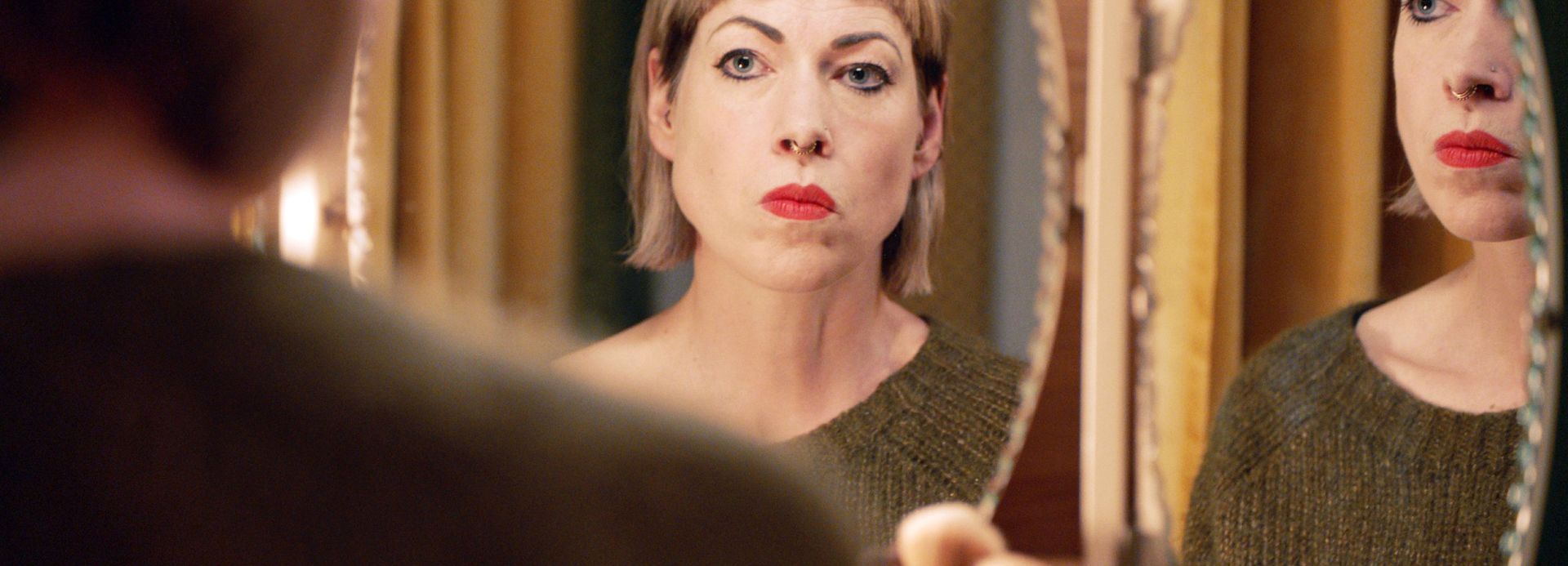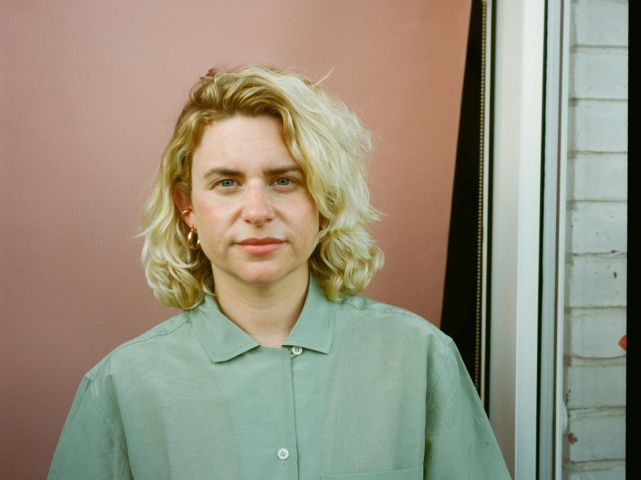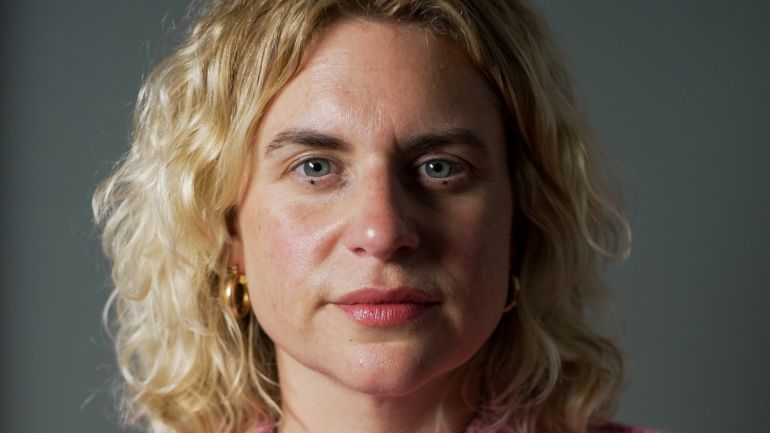
An interview with Rosie Morris, director of 'My Blonde GF', who is shining a light on the issue of deepfakes. By Tess Lowery.
The pope in a puffer jacket. Not Morgan Freeman. A remake of 'The Shining' starring Jim Carrey. Jerry Seinfeld cast in 'Pulp Fiction.' European politicians duped into calls with the mayor of Kyiv. Selma Hayek’s stolen likeness in TV show Black Mirror. For the most part, the conversation around deepfakes has revolved around either questions of international security and the threat to democracy or simply what happens when famous people have their image stolen.
Yet, most deepfakes don’t fall into either of these categories; they’re of ordinary people. In fact, 96% of deepfakes are non-consensual porn, and of those, 99% are of women, according to a 2019 report by Sensity, a company which detects and monitors deepfakes. Found through Google, bought with Visa and Mastercard, deepfake porn is its own economy, according to an investigation by Kat Tenbarge for NBC News in March of this year.
Despite the fact that deepfake technology has been available since at least 2017, legislation around it is lagging. It wasn’t until August of this year that the EU introduced the AI Act — proposed legislation that will not bar the use of deepfakes outright, but will attempt to regulate them through transparency obligations placed on the creators.
In 'My Blonde GF,' Helen discovers that deepfake images of her in sexually explicit and violent scenarios have been uploaded onto a porn site and goes on a journey to understand what has happened to her.
We sat down with director Rosie Morris to go behind the curtain on her latest documentary film.

How did the subject of deepfake porn become something you wanted to create a film about?
I made a film in 2018 called 'Heart Eyes and a World' about the impact of the selfie and social media on teenage girls.
After observing how the internet was infiltrating their daily lives, I was struck by the fact that when we share photos of ourselves, they are no longer ours. Something so intimate becomes something that anybody can take and use how they want to. And because of the way we live our lives online we may not be sharing photos of ourselves via social media, but there may still be photos of us online.
I lived half my life without social media and half of my life with it, so I was thinking about the early days of Facebook and how we all went along with it. But what were we actually unwittingly participating in by doing that? I had all of these things going around in my head and then I read an article during the lockdown that said that there had been a huge surge in revenge porn and deepfakes during the lockdown.
I started looking for examples and I found Helen’s story in a BBC News article. I contacted her and said, 'I'd be really interested to talk to you about this.' As soon as I talked to her, I just wanted to understand everything about how it felt for her to have this happen to her and how it had impacted her life. The technical side of what happened to her is one thing, but actually the kind of psychological disturbance is what I really was interested in exploring. I felt that if you showed that through the film, people would get a deeper sense of why we need to address the laws around image-based abuse.
You don’t actually show the deepfake in the film. Can you tell me about this decision?
That was the choice from the very beginning. I think partly that's because when you take on a complex story like this, you have to think about the ethical framework for it that is going to be the thing that guides all of your creative choices. From my point of view, I was never going to show the images or perpetuate any of the original imagery, which was like an ethical choice. I also knew that if we didn’t [show them], you would keep the focus on Helen’s experience of seeing the images rather than the images bulldozing the whole story which is what they would have done. What you've got is Helen’s point of view on the images. When she's describing the images that she’s seeing, you're imagining what that must feel like to be her seeing those images of herself.
It was an ethical choice, but at the same time, it helped creatively to really put a fine point on what we were trying to achieve, because it became a real challenge making a film about images and not being able to use any of those images. It's almost like that was the baddie that you had to keep away and keep out of the film. But I knew that if you made a really strong choice about it then that would become a key characteristic of the film.
AI-generated imagery within the film industry has gone mainstream. What are your thoughts on that?
I find it really unsettling. It’s not even the technology, it’s the motivation and intent and the problem we have with the truth. As we've seen, it's quite hard to understand the truth these days because there's so much to be said about everything and you have access to absolutely everything online. But for me, there's something about how that is now transcending human faces or human voices, that makes it deeply disturbing.
What I was interested in with this story is that it sounds like it could sort of be quite superficial. Okay, so somebody just took pictures of you, and then they put them into this other context, but it didn't really happen. As soon as I met Helen and started talking to her, I realized that there is a very inextricable link between memory and image. What troubles me is that somebody's changed an image but the image has a very specific memory attached to it. Now, the memory is the thing that's changed its meaning. You can sort of go into somebody's brain and change something that is already theirs, that is their possession, something that you would never imagine could be altered. They're the sort of philosophical questions that are behind this story.
In terms of the film industry and AI, I mean, it’s limitless, isn't it? And obviously there needs to be laws created around this stuff. But laws aren't going to stop people doing things. I think we have to question the culture.
Clearly, we don’t have the legal framework to deal with deepfakes. What do you hope the impact of the film will be?
The reason I found Helen’s story was because she decided that she wanted to speak about it and raise awareness about it. When she reported what had happened to her to the police, they told her there was nothing they could do because the images were fake. What we're doing with this film is trying to probe that idea of “fake.” What is a fake image? You see an image and you perceive it as a complete image. So, in a way, the problem is the intention behind the deepfake. It’s not like what happened to Helen is really high tech. It's somebody in their bedroom with Photoshop.
In the UK, the laws are changing around this at the moment. The reason that we're bringing the film out at this time is to try and raise awareness around the details of the impact. Nobody's seen the details of the Online Safety Bill, which is what's being revised at the moment. People are paying attention and that's really good and it has a lot to do with the work of people like Helen, who decided to speak out about this which is not an easy choice and isn’t for everybody.
Helen says that the reason it's not for everybody is because a lot of the time when women choose to talk about things like this, they get backlash and there's a never-ending cycle of abuse.Helen is a writer and a poet so she decided to raise awareness and question the culture and the laws. What we were thinking is that the legal stuff won't necessarily stop people but [it could mean] there's support and validation for the victims.
My agenda as a filmmaker is that I want to put you in that experience so that you understand it.
With the film my hope was that you come into it thinking “Oh, that sounds horrible.” But when you actually walk alongside [Helen] through the film, you get a deeper sense of how impactful it was and actually how a situation like that could upturn somebody's life.
How do you think that gender plays a role in deepfakes? Is this just another form of gender violence?
It's really tricky, because I'm not saying that this doesn't happen to men. I'm sure that it does. But we use a statistic in our film: 96% of deep fakes are non-consensual porn featuring women. Part of the reason we use that [statistic] is because when I started out making this film two years ago, there was a strong misconception that deepfakes were all political videos or famous people. That statistic reveals that that isn't really the case. Women are a target for this kind of online abuse.
I think it comes from the same place as a lot of other kinds of abuse towards women, from a desire to render somebody powerless. I was talking recently about the big surge in people having their drinks spiked after the lockdown. For me, this comes from the same place. It's about rendering people powerless.
Yet again, I feel like women are the target of that. And I don't want to say exclusively because it isn't, but I can tell this story. I can relate and connect with Helen and try to tell this side of the story.

There is a double violation when thinking about these images. Both at the moment they are created but then again when they are consumed. Filming is quite an intrusive process. How did you work to not reproduce the violence of the gaze that consumes these images?
It's really complicated. You have to be really careful about perpetuating the exact thing that you're trying not to do.
With Helen, there were lots of stages to this process, but at the heart of it is relationships. We developed our relationship over quite a long period of time. When I first spoke to her, she was still trying to understand what had happened to her. Through our conversation, she felt she was developing a deeper understanding which meant a lot to me. It was a reciprocal process.
My producer, Rebecca Mark Lawson, who runs Type Films, lives really near Helen and they developed a supportive relationship. What you're talking about is actually not something you can really put your finger on. It's like an alchemy that comes from a group of women making a film and telling a story because they feel like that story really needs to be told. That's what it comes down to.
It was a really rewarding process because Helen’s really extraordinary and really wants to understand what it all means to her. I really admire her so much for that. I think that really comes through in the film. She's trying to find the words for something which is quite hard.
The development of the relationship was really long and the shoot was really short and really focused. And now, the relationship continues. Ultimately, the film is a result of a series of relationships and a series of collaborations and everybody being on the same page and knowing “this is why we're telling the story.”
The film is quite obviously a documentary but with a lot of aesthetic choices. Can you talk about these choices?
I'd never made a film that has a story where all of the drama has already happened and you're telling it retrospectively. That was a really big challenge because my films tend to be observational. I really wanted to create an atmosphere and a tension in the film.
We were making this film a year after it had happened. We had to work really hard to bring the atmosphere. I listened to Helen a lot and really got an understanding around what that felt like at the time and thought “okay, how are we going to recreate these feelings of isolation, of claustrophobia, of disorientation of the world spinning?”
We made the decision to use eye direct which we knew could have quite a claustrophobic feel. I wanted viewers to feel that the darkness of what had happened was huge around her and really isolating. I wanted that because that's what she told me it felt like. It wasn’t based on nothing, it came out of those conversations we had.
Some people would see [the film] as a kind of reenactment, but I just asked her what she did in those days after the event. She told me the story of what she did in those days after this happened and how what had happened to her revealed itself in her life.
It wasn't straightforward. She didn't instantly know how it felt. It revealed itself quite slowly. After the initial shock, [there was a] kind of residue. We filmed her picking her son up from school. We filmed her sitting having a fire with the family. We filmed bath time. We filmed various things around the house that she told me about.
Her motherhood was really important to her because this event had infiltrated her personal and domestic space. I wanted to show you that [the perpetrator] was at home with her, had attacked her and infiltrated the space of her house which was one of the worst aspects about it.
All of the things that we filmed were based on me trying to understand what that period of time was like for her. We wanted the space of the photos to be quite different from the rest of the material. Some of the settings that I put Helen in, they all relate to what she told me she did around that time. It's not reenactment, it's about routine and repetition and it puts you back into that headspace that she was in.


